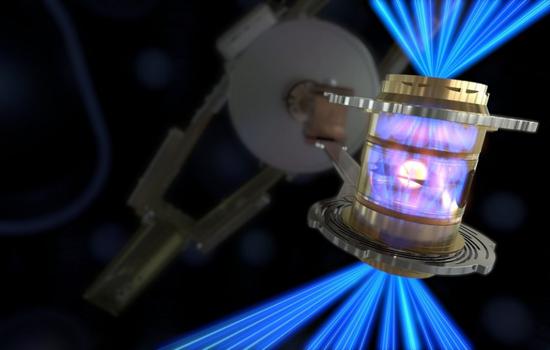U.S. announces breakthrough on nuclear fusion energy

Photo posted on Dec.13, 2022 shows the nuclear fusion ignition experiment at Lawrence Livermore National Laboratory's National Ignition Facility, in Livermore, California, the United States. (Photo credit: Lawrence Livermore National Laboratory)
The U.S. Department of Energy (DOE) on Tuesday announced breakthrough on nuclear fusion energy.
The achievement of fusion ignition was made by scientists at the Lawrence Livermore National Laboratory (LLNL).
On Dec. 5, a team at the LLNL's National Ignition Facility (NIF) conducted the first controlled fusion experiment in history to reach this milestone, also known as scientific energy breakeven, meaning it produced more energy from fusion than the laser energy used to drive it.
The DOE called it a "major scientific breakthrough" decades in the making that will pave the way for advancements in national defense and the future of clean power.
The NIF, the size of a sports stadium, uses powerful laser beams to create temperatures and pressures like those in the cores of stars and giant planets, and inside exploding nuclear weapons, according to the DOE.
The achievement will provide invaluable insights into the prospects of clean fusion energy, which would be a game-changer for efforts to achieve a net-zero carbon economy, according to the DOE.
"This is a landmark achievement for the researchers and staff at the National Ignition Facility who have dedicated their careers to seeing fusion ignition become a reality, and this milestone will undoubtedly spark even more discovery," said U.S. Secretary of Energy Jennifer Granholm in a statement.
The LLNL's experiment surpassed the fusion threshold by delivering 2.05 megajoules of energy to the target, resulting in 3.15 megajoules of fusion energy output, according to the DOE.
It demonstrated for the first time a most fundamental science basis for inertial fusion energy (IFE), said the DOE. But many advanced science and technology developments are still needed to achieve simple, affordable IFE to power homes and businesses.
The DOE is currently restarting a broad-based, coordinated IFE program in the United States.
Combined with private-sector investment, there is a lot of momentum to drive rapid progress toward fusion commercialization, said the DOE.
Fusion is the process by which two light nuclei combine to form a single heavier nucleus, releasing a large amount of energy.
In the 1960s, a group of pioneering scientists at the LLNL hypothesized that lasers could be used to induce fusion in a laboratory setting.
This revolutionary idea later became inertial confinement fusion, kicking off more than 60 years of research and development in lasers, optics, diagnostics, target fabrication, computer modeling and simulation, and experimental design, according to the DOE.
To pursue this concept, the LLNL built a series of increasingly powerful laser systems, leading to the creation of the NIF, which is the world's largest and most energetic laser system, according to the DOE.
